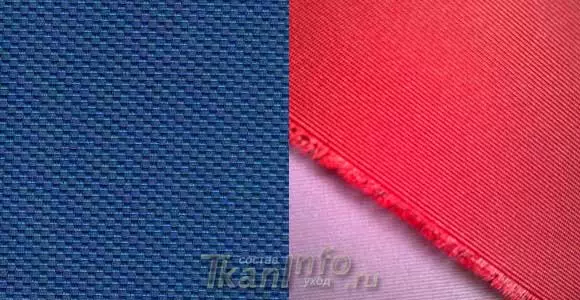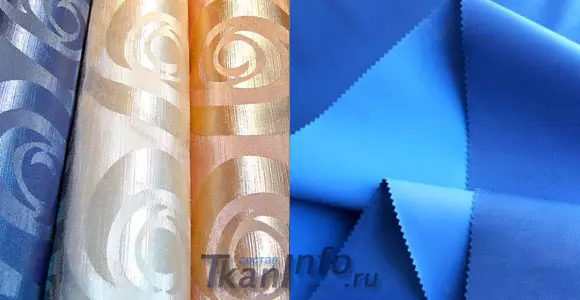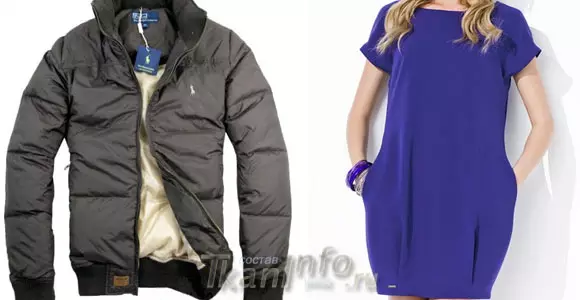Polyester is considered to be one of the most popular synthetic tissues. According to different calculations, polyester fiber is about 60% of the textile market. Polyester is used to sewing light dresses, outerwear, furniture upholstery, workwear and much more.
Many people try to choose clothing from completely natural fabrics, believing that the synthetic material is harmful and uncomfortable in the sock. This opinion is not quite fair. High-quality polyester produced on modern equipment, not only safe, but also practical, beautiful and inexpensive material.
Polyester is a cloth obtained from polyester fibers.
It should be borne in mind that the inscription "100% polyester" can be on the labels of completely different in appearance and product properties. Characteristics depend on the shape of the fiber and their additional processing.
Production
Pure polyester is made of oil, gas and products of their recycling. The process takes place in several stages:

- Isolation of the components required for the manufacture of polystyrene (raw materials for future fibers).
- Obtaining melt - liquid polyester.
- Mechanical and chemical polyester cleaning.
- Production of fibers: the semi-liquid mass is pushing through very narrow holes.
- Finishing, refining and giving additional qualities.
- Manufacturing directly tissue.
Trying to improve polyester, chemists combine polyester with various natural, synthetic and artificial fibers. As a result, the fabrics are disliked on each other, little inferior in quality and beauty with natural materials.
The quality of the fabric depends on the compliance of the technological process. Have a good polyester there is no unpleasant smell, such a synthetics does not leave the peel on the skin and does not learn . In clothing from high-quality synthetic material, you can comfortably play sports, rest or work physically.
Appearance and main characteristics
100% polyester may be thin translucent veil or strong cloak. The appearance and properties of tissue from polyester fibers depend on the chemical composition of raw materials, fiber shapes and type of weave. Very often, the polyester looks and felt like wool, and its properties resemble cotton.
Article on the topic: Puppet house from plywood with your own hands with photos and videos

Polyester Description:
- High degree of protection against adverse weather conditions (low temperatures, wind, ultraviolet radiation, rain and snow). In the clothes from the polyester almost always warm and dry.
- Wear resistance. Polyester fiber is resistant to stretching, friction and other types of physical impact.
- Simple care. Polyester is easily erased, dries quickly and almost never mind.
- Good resourceability. The fabric is easy to lure, sew and process.
- Resistance color and shapes. With proper care, the polyester does not fade and does not fade.
- Small weight.
- Lower cost compared to natural tissues.
- Protection against pests and mold. 100% synthetics will not interest the larvae of moth or other insects.
- Good water repellent properties. In addition to protection against precipitation, this quality prevents the appearance of spots.
- Low elasticity. Due to this, the fabric does not stretch, and clothing retains the form well.
- Does not absorb smells.
Changing the shape with strong heating can be attributed both to the disadvantages and the advantages of the tissue. On the one hand, it gives additional possibilities when designing clothes or decoration. After all, to get all the necessary items, it is enough to heat the cloth, form and fix the desired fold. And on the other, with a careless ironing, you can get an unwanted room or a bend on clothes, to get rid of which it will be impossible.
Tight knitwear, openwork lace, warm lining or smooth elastane are obtained using various ways to connect fibers and weave threads. A variety of fabric textures will satisfy the most picky fashion designer.
Cons and weaknesses:
- High density. It is important to remember that the properties of clothing made of pure polyester make it not very comfortable for wearing in the heat.
- The impossibility of using chemical bleaching. Polyester fiber can collapse.
- Electrification. Synthetics accumulates static electricity, because of this, the dust can stick to the clothes, and the fabric itself is attracted to the skin. These minuses are easy to eliminate if using an antistatic or special air conditioner for linen. Many manufacturers are added to the fiber thread with an antistatic effect.
- Some stiffness of the material. Sometimes, to make it softer, elastane or cotton add.
- In violation of technology, polyester fiber can cause allergies. When buying clothes, you need to remember that too cheap polyester can be harmful to health.
- Fiber is poorly staining.
Article on the topic: Openwork pullover spokes of cotton and mohair: Schemes and description
Care rules
There are no special requirements for caring for a polyester, but in order to maintain the original characteristics of the product, when it washed and ironing, you need to comply with simple rules:- Consider manufacturer's recommendations. This is especially important for clothes having special properties (heat and moisture protection).
- When choosing a washing mode, it is important to remember how many degrees can withstand clothing from polyester. Usually polyester can be washed at 40 ° C and lower. More hot water will lead to fiber deformation, and the thing will lose the form.
- It is best to choose a mode for washing synthetic or delicate.
- Fabric can not be bleached. Clothes with complex stains can be handed over to dry cleaning.
- For particularly thin fabrics, manual wash is desirable.
- It's better to wash things by turning them inside out to not damage the face.
- Separate types of polyester, for example, knitwear, can not be twisted after washing.
- So that the fabric does not remember, you need to raise the product after washing on the shoulders and straighten well.
- How to iron polyester if the clothes are nevertheless? This can be done, but at a minimum temperature from the wrong side through a thin cotton fabric or gauze.
- Some types of polyester materials are impossible.
In the network you can find tips that the thing from the polyester can be stretched. To do this, it is proposed to rinse it in a warm acetate solution, stretch and fix it until completely drying. Guarantees that the experiment will be successful, no. But it is possible to spoil this way in this way.
The material, which consists of 100% polyester, is sufficiently low at cost, so it fell in love with people who are just beginning to comprehend the basics of sewing.
Types of materials and scope of application
Now polyester fiber is rarely used in its pure form. The threads add elastane, cotton, viscose and other components. This allows you to get fabric, knitwear or nonwoven material having additional properties. Polyester is most often added to increase the strength and wear resistance of the product.
Article on the topic: Friform for novice crochet: Master class with models
Elastane in combination with polyester enhances the elasticity of the fabric. It is better stretched, which allows the use of elastane in the production of underwear, sportswear, swimsuits. The most common composition from which Polyester Stretch is made, Elastane (5 - 15%) and polyester (85 - 95%).

The general description of the fabric, which includes polyester and elastane:
- perfectly stretches in one direction, and sometimes in all;
- resistant to wear;
- does not mind;
- most often has a smooth facial surface;
- With sock there is no "greenhouse" effect;
- Well holds the shape after washing.
What makes the "oil"? This knitwear, which includes polyester and elastane. Such knitwear is well holding heat, but does not interfere with the circulation of air, dense and rather heavy.
Microwave is also knitwear with a significant inclusion of polyester (70%) and the addition of viscose (30%), in appearance resembling natural silk. This material is well stretched in any direction, then takes the source form.
What makes numerous types of insulation? The basis for their production is polyester fiber. Nonwoven material obtained from polyester is used as a filler for outerwear. Such insulation are called differently and to various degrees are maintained. The most famous nonwoven material from polyester - Hollofiber. His hollow fiber provides better protection from the cold, does not fall and holds the shape of the product after washing.
From polyester make isosoft, sintepon, polyfiber, Fireburskin, thermofab and tensulite. It is believed that the properties of the latter allow you to preserve the best and not allow to freeze in frosts.
Another niche, which Polyester has almost completely occupied, is lining and upholstery materials. Such a lining is not stretched, does not let the heat and water, does not occur and long retains the initial look. Polyester lining is used in the manufacture of outerwear, suits, trousers and dresses. Lining for winter clothes often has additional heat-shielding properties.
